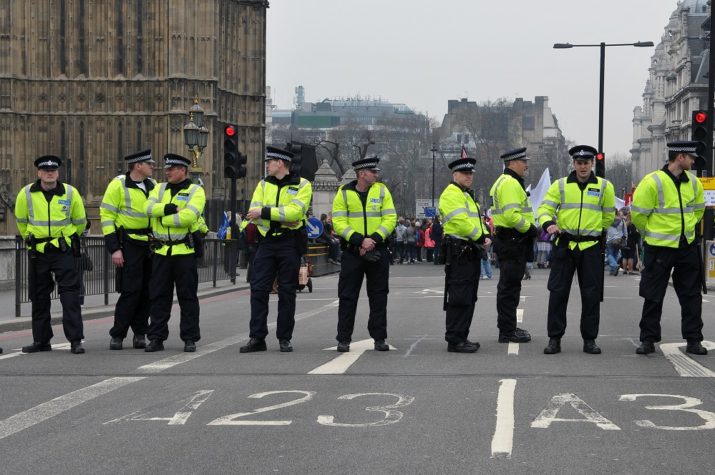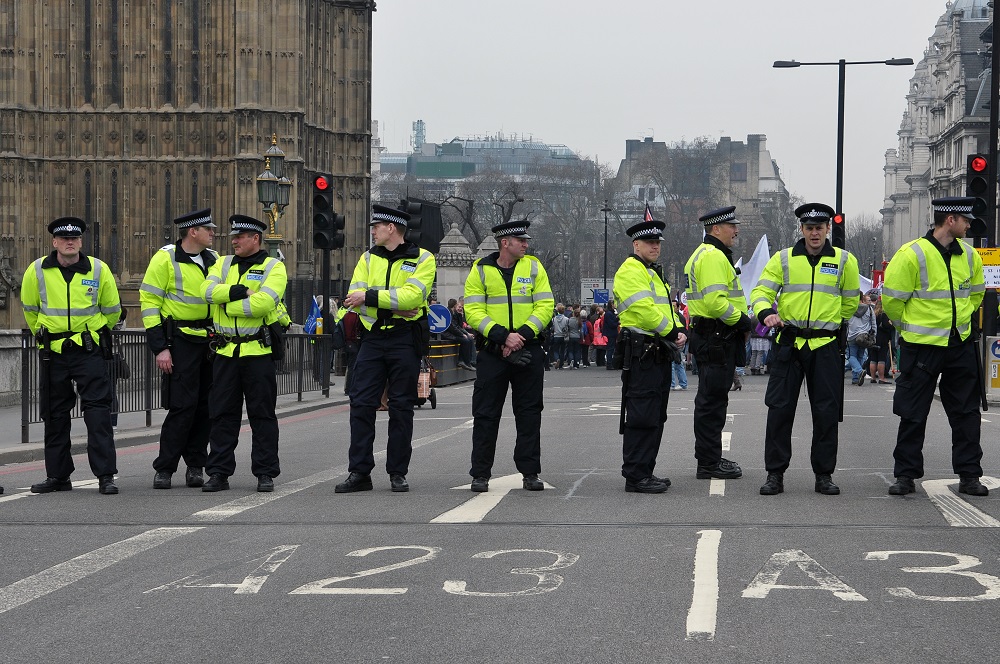

This is part of our special feature on Radicalism and Violence.
Established in 2003 as a broad strategy to stop society from turning to violence, The Prevent program is the contentious attempt at preemptive counter-terrorism in Britain. It supposedly brings together security and safeguarding of the vulnerable, although there are concerns at a UN[1] and civil society[2] level that the strategy does not work, and could be counterproductive. This discussion focuses on how the most purportedly-risky Channel cases (sitting within Prevent) have little if anything to do with what has traditionally been considered security, despite the public narrative that Channel interventions are “helping to save lives.”[3] Using interviews with secretive intervention mentors and senior figures from within Prevent, the following article—after briefly introducing the program—explores the types of behaviors deemed relevant to what is allegedly a security policy, how an individual is moved through the process of Prevent and into Channel, and how a risky individual is reconfigured into a “safe member of the citizenry” by learning the art of critical thinking. The discussion points to a biopolitical exercise of power, gradually becoming more apparently pervasive: today’s Britain employs the identification and preemptive subjugation of extremely loose, possible future threats, for the purpose of securing the whole population.
Introduction to Prevent
The Prevent program tries to stop people becoming drawn into, supporting, or engaging in violence based on twenty-two supposed “signs of radicalization.”[4] The program has moved through several different iterations, focusing, in its early years, specifically on Muslim communities who were targeted with explicit funding, to a whole-of-society approach where specific community work has become less overt. Now, the entire population is being encouraged to exist through a lens of fear and suspicion, having gradually been given the responsibility for more and more security tasks. The police have called for all individuals to become “counter-terrorism citizens”[5] and to remain ever-vigilant, and to report what probably isn’t a security threat, but which could be: anyone who has interacted with public transport in Britain will have come across the irksome “see it, say it, sorted” campaign. This “better safe than sorry” logic runs through the core of Prevent. Since the early 2000s, when it was designed, people have been referred to Prevent, although in its earliest form it was interested in demonstrable intent to commit violence, whereas since 2010, it securitized ”non-violent extremism.”
Officials categorize and prioritize which individuals they deem to constitute a potential threat against Britain, with the most purportedly dangerous people receiving a ”voluntary”[6] intervention with a mentor on the Channel program. In 2015, through the Prevent Duty, public officials (from teachers to nurses) became legally obliged to report their clients (pupils and patients) for demonstrating some ”radicalization risk.” Prevent referrals are sent through to local Prevent police teams, who then go and speak with the individual if it is deemed necessary, and cases move up to the Channel panel if the team feels the individual poses a sufficiently great risk. Multi-agency Channel panels (essentially a group of safeguarding leads) then determine based on the Extreme Risk Guidance (ERG) principles— the twenty-two ”risk factors” developed outside an academic context—how the referral will be actioned, with non-risky referrals filtered out, many signposted to other services, and the ”most dangerous” offered mentorship with a Channel intervention provider. Following the Prevent Duty, there are now roughly 7,000 accepted referrals per annum, with some 300-400 moving through the Prevent process to receiving a one-on-one Channel intervention.
”Risky” Behaviors
The reasons referrals are accepted vary wildly, but all have some relation to the ERG 22 principles, which include “them and us thinking,” “excitement, comradeship and adventure” and “mental health.” Interviewees noted that risks varied from location to location, and also that the same sorts of risks were considered differently depending on the area.
Several issues around alleged risk were recurrently brought up. It was commonly noted, for example, that individuals of concern to Prevent largely display several risk factors; often referrals are not accepted for a single reason. Prevent officials indicated that many referrals from teachers, who had reported concern over students who had ”only” watched beheading videos, were rejected by the Prevent police teams, as most of these cases were not apparently related to an ideology, or correlated with other supposed risk factors like social isolation or mental health issues.
However, some factors were repeatedly referred to, in particular the role of mental health in ”making somebody vulnerable” to violent tendencies (be they acted out or merely imagined). One interviewee, the director of a company delivering Channel mentorship who also personally delivers interventions, found it difficult to differentiate between ”vulnerability to extremism” and the possession of mental health conditions, a rather worrying turn given the sensitivities of stigmatizing mental health. Literature on Prevent similarly links mental health with the movement towards terrorism. Through such discursive repetition, the trajectory to political violence is becoming reconstituted as knowable, as correctable, and as based on irrationality and a lack of cognitive ability:
A large proportion of people who may have learning difficulties or a neurodevelopmental disorder such as ASD, Asperger’s, [or] autism, have an increasing risk because of the way they can be radicalized. (Interviewee 12, Channel mentor, former regional Prevent coordinator)
Though other interviewees did not echo these views as emphatically, the relationship between vulnerability to extremism and mental health was consistently highlighted. Just as there are gang work Channel mentors, ex-far-right and ex-jihadist mentors, there are also mental health specialist Channel mentors—compounding in practice the imagined links between mental health issues and political violence. Another mentor mentioned around half of his cases had ASD. Of course, as practitioners often point out, many of their cases do have mental health conditions. However, these cases are purely those who have made dangerous-sounding utterances, and have been accepted as referrals to Prevent on its own logic (under the ERG principles), rather than having scientific research suggest these sorts of people do pose a security risk.
Individuals who are not seen to possess an ”ideology”—whilst making the same sorts of divisive or threatening comments as those who are—are not of interest to Channel panels, and across the country they are only picked up and mentored unofficially by Prevent police teams if the teams have sufficient time. Despite academics (Neil Ferguson, John Horgan, Tore Bjørgo) clearly and consistently discrediting the case for a causal link being made between ideology and violence, this obvious distinction Prevent makes between ideology-ridden and non-ideological cases is an everyday practice across Britain.
Those who do end up on the Channel program because of the possession of an ideology were sometimes retold as very concerning:
We had a kid celebrating the Finsbury Park attack. There were other factors of concern as well. But the way he was doing it, it was not just what he said but what was so concerning was the way he was saying it, and the way he was trying to galvanize his schoolmates around this issue. (Interviewee 7, senior Prevent official)
Whilst some, like this example, may indeed sound concerning, there is a well-established lack of academic rigour upholding the logic of interventions in these cases. Moreover, the threshold is as low as challenging racism for the sake of racism. Two mentors mentioned that Channel panels occasionally asked them to perform an intervention with an individual, because even though they did not demonstrate intent or capability, they were making racist remarks. The mentoring was sanctioned along the grounds that “racism in itself still deserves to be tackled.” (Interviewee 8, Channel mentor.) Mentors are occasionally told by Channel panels that they know the individual doesn’t have intent or capability, but he or she still needs putting back on the right path and setting straight. With the national security framing around Channel and the mantra that Prevent isn’t the “thought police,” these sorts of accounts sit awkwardly—outside of considering the interventions as a broader element of the biopolitical urge to manage, govern and promote life, which necessarily includes suppressing possible mutations and possible future threats to life, no matter the severity.
The sheer triviality and breadth of such an approach towards risk (seeing mental health as an inherent ”vulnerability,” correcting racism within a counter-terrorism strategy) highlights the depoliticization and de-exceptionalization of the discourse around terrorism in Britain—an act which has historically been considered among the most destructively potent of political communication. One of the most senior figures within Prevent epitomized this disempowerment of the actor, and the decoupling of the role of terrorism as communication:
The idea that just because Mohammed Siddique Khan said ‘I did this because you invaded Iraq’… and that somehow we then say ‘well he did it because of Iraq and if we weren’t in Iraq then this wouldn’t have happened’ is far too simplistic… He’s not gonna say ‘I’m not a person who’s not integrated in my local community by the way… and I’ve got some broader issues that I’m dealing with’… So we’ve got to break down what has actually happened in his life… It’s all very well that he says ‘I did this for Iraq’ and heroize [sic] himself in that way but that doesn’t mean we take that at face value. (Interviewee 16, senior Prevent actor)
The logic holds within its own internal parameters that take individual psychology as the main ”driver” of the trajectory towards terrorism when the debate remains entirely contested—as the architect of Prevent accepted—and it ignores decades of academic research[7] on terrorism and different forms of conflict.
The intervention
Despite banal Freedom of Information requests consistently being denied on the grounds of national security, and, for the same reason, Channel mentors unable to speak about fairly pedestrian data, such as how many cases they have taken on, most interviewees framed their duties in terms of safeguarding and social work, with little-to-no discussion about how it diverted people from engaging in terrorism (let alone the absence of academic work on this topic).
Where nationally the strategy is lauded as having “saved lives,” in answering the question, “Have you come across anyone you thought was actually likely to pose a risk,” one Channel mentor of five years replied, after thinking, “Possibly one person, possibly one person.” A senior Prevent official, answering a similar question, pointed to an individual who had a tendency towards aggression because of mental health issues, and who’d been in Channel for some time. The official pondered the chances of him committing an act of terrorism: “He’s threatened to, he’s threatened to behead people. Would he do it? I couldn’t tell you.” This was the only case this particular official brought up as posing some real risk. These two accounts were not atypical; similar themes of a lack of apparent threat were consistent across the interviews. One mentor spoke explicitly about this minimal risk:
I might come into a certain person’s life where they’re already disengaging [from ‘extremism’]… so their risk of acting violently is declining. But in terms of their attitudes, they might still hold strongly radical attitudes compared to you and me. (Interviewee 1, Channel mentor)
In trying to determine the risk that individuals receiving Channel mentorship actually posed (aside from being labelled a potential future terrorist threat by a group of safeguarding leads), I asked mentors, “Is the legitimacy of violence something you’d talk about with your Channel cases?” A typical reply is as follows:
Only if it’s relevant. One of the important things in doing Channel, because it is pre-crime space, you don’t want to exacerbate, introduce or create a problem which wasn’t there when you started. (Interviewee 8, Channel mentor)
Many mentors talked about this reluctance to bring in a discussion of violence because they didn’t want to introduce the topic to subjects. Another mentor, talking about a young boy on Channel, commented that he:
“is not trying to be a terrorist… he doesn’t want to harm people, but he’s coming across material which is attractive because [of] the way it’s presented or the issues they’re talking about.” (Interviewee 10, Channel mentor)
For individuals not even imagining violence and people not wanting to harm anyone, to be brought into the state’s counter-terrorism strategy, suggests a lot about how risk is being conceived within British security. It indicates a strong desire to suppress not only divergent opinions but behaviors that could lead to divergent opinions (this particular child had watched some ISIS propaganda videos). Such an approach suggests a chronic intolerance of liberal governance to deal with different ways of perceiving existence. Bringing these sorts of children (children are a focus of Channel, because of their malleability) onto Channel encourages logics of suspicion into the everyday and normalizes securitization. These logics are enabled to spread and develop in part through framing reformulations: the notion that counter-terrorism could also be considered safeguarding was realized and implemented. One interviewee noted that after Prevent was facing resistance in one local area, decision-makers decided to reframe their activities:
So we said ‘OK we’ll get rid of the term Prevent and work in the community and talk about ‘how do we safeguard these people?’ It’s amazing how people change. (Interviewee 12, Channel mentor, former regional Prevent coordinator.)
Leaving the program
Ultimately, according to the officials, a Channel intervention aims to support individuals towards thinking more critically (in less binary, black-and-white terms), to have provided expedited support where deemed necessary (mental health, housing, social work), and for the individual to have been better socialized (often with people they held negative views about). Supporting cases into employment is also often a part of a successful so-called “disengagement process.” Practically, the sessions involved chatting with mentees in cafés, religious discussions, sending individuals on professional leadership training courses, and so on. Although the few very longest interventions last up to a couple of years, cases can get sanctioned by Channel panels for two, three, or four sessions. The average intervention is sanctioned for somewhere around six and eight sessions, where cases meet with their mentor for an hour or two (very rarely the most intense sessions can last “a whole afternoon”), once or twice per month. These sessions do lead to people getting jobs, prioritized mental health support, and undoubtedly people seeing the world in less divisive terms. But to suggest such low exposure could lead to an individual moving from potential involvement in terrorism to a safe member of society seems optimistic, and despite claims of success that 84 percent of people going through Channel are “disengaged from extremism,”[8] the divergence is not verified by any external oversight, or any other measures than a mentor’s intuition and by the ERG principles, which (regardless of how much Prevent officials believe) themselves have not been academically verified.
Despite the focus on non-terrorist related endeavours (to the point of sometimes even avoiding discussions on violence), the mentoring was described as “disengagement.” The process of disengagement has historically been considered in academic literature in relation to a physical movement away from prior physical involvement in a dangerous physical activity (like political violence, or gangs), having no basis in research, but purely in relation to ideas themselves. Yet, this was a common theme across the interviews.
When the “silver service social work” starts to impact on the mentee—and according to Vulnerable Assessment Framework forms (which are based on the ERG principles)—alleged risk starts to recede, the mentor updates the Channel panel. Things like body language affect how an IP views the subject’s movement from ”risk” to ”no longer risk,” or how, in practitioner terminology, the individual has “disengaged from extremism:”
You can tell from the way they ask questions and you can tell from how they’re listening to you, are they attentive, are they looking at their watch, playing with their phone, so it’s all manner of things. Body language gives it away, it’s dead easy, body language and I’ve studied [it]. Not professionally but I’ve looked into it you know. You can tell and I’m a people person myself. (Interviewee 3, Channel mentor)
Once alleged risk subsides enough, the mentor and Channel panel discuss the case and fill out a final form, the Channel panel decides no more meetings will be sanctioned, and the case is concluded. The individual will be followed-up in two six-monthly instalments to make sure they haven’t “re-engaged with the ideology.” The circularity of the process — with only internal metrics of risk being used to legitimize the process—ensures it remains internally sound. Practitioners did not consider, in the interviews, that the alleged indicators of radicalization may not be causally linked to threat, or that people move towards engaging in political violence without demonstrating these signs.
Conclusions
Despite sitting within the ”Prevent” strategy, preemptive counter-terrorism interventions in Britain have no apparent relation to any demonstrable preventative mechanism. Similarly, the misleading term ”pre-crime” suggests that these Channel interventions are helping to curtail future crimes, as though there was some logic of knowable linearity (unproven in practice and literature). Channel subjects, by the accounts of their mentors and senior figures within Prevent, are not being diverted from any determinable movement or trajectory towards terrorism, and any risk they pose appears entirely negligible. Channel cases are largely banal, with a number being actioned only to combat racism for the single purpose of combating racism. This was corroborated by how many of the ”disengagement” or ”counter-radicalization” mentors see their role: as glorified social workers. Whilst some individuals clearly do make concerning-sounding remarks coupled with mental health issues or social isolation, Prevent actors did not demonstrate, nor does academic literature suggest, that these utterances may indicate a movement towards posing a security threat. Especially juxtaposed against the Home Office narrative of the program “having saved lives,” the banal work undertaken by Channel outlined in this discussion highlights a securitization of dangerous-sounding, radical opinions with no scientific rigour or external oversight. This state of affairs points to a broader strategy of the foreclosure of society for the purpose of easier population management, as though we had reached the pinnacle of existence, or at least that somewhere close to the status quo is sufficient, and we should all—in the words of many Prevent officials facing criticism – “just get on board with the program.”
Tom Pettinger is a PhD researcher at the University of Warwick in the field of critical security studies, looking into preemption in British counter-terrorism. His focus in on how the state sees the movement of citizens into non-state violence, how it is contrasted with the testimony of those who have formerly been engaged in political violence, and how the conflict in Northern Ireland has been entirely forgotten.
Photo: LONDON – MARCH 26: Police stand guard on Westminster Bridge | Shutterstock
References:
[1] UN Office of the High Commissioner, 2016. Statement by the United Nations Special Rapporteur on the rights to freedom of peaceful assembly and of association at the conclusion of his visit to the United Kingdom, https://www.ohchr.org/EN/NewsEvents/Pages/DisplayNews.aspx?NewsID=19854&LangID=E, United Nations Human Rights: Office of the High Commissioner, published 2016, accessed 20/06/18
[2] Muslim Council of Britain, 2015. Meeting between David Anderson QC and the MCB, https://www.mcb.org.uk/wp-content/uploads/2015/10/20150803-Case-studies-about-Prevent.pdf, MCB, published 2015, accessed 20/05/18
[3] Wallace, B., 2017. Security Minister statement on today’s publication of Prevent and Channel data, https://homeofficemedia.blog.gov.uk/2017/11/09/security-minister-statement-on-todays-publication-of-prevent-and-channel-data/, Home Office, published 09/11/17, accessed 09/11/17
[4] HM Government, 2012. Channel: Vulnerability assessment framework, https://assets.publishing.service.gov.uk/government/uploads/system/uploads/attachment_data/file/118187/vul-assessment.pdf, published Oct 2012, accessed 09/11/17
[5] BBC, 2018. Police call for more ‘counter-terrorism citizens’, https://www.bbc.co.uk/news/uk-43465966, BBC, published 20/03/18, accessed 20/03/18
[6] Refusal to work with Channel is used as evidence in family court trials. Furthermore, national police lead for Prevent said those refusing may directly lead to a Pursue investigation: Cole, S., quoted in Hooper, S., 2017. EU embraces UK counter-extremism policies despite human rights concerns, https://www.middleeasteye.net/news/european-embrace-uk-counter-extremism-policies-despite-human-rights-concerns-1550167935, Middle East Eye, published 05/05/17, accessed 05/05/17
[7] Jackson, R., 2012. ‘Unknown knowns: the subjugated knowledge of terrorism studies’, in Critical Studies on Terrorism, 5(1): 11-29
[8] Baldet, W., 2017. The resistible rise of far-right extremism, https://guce.oath.com/collectConsent?brandType=eu&.done=https%3A%2F%2Fwww.huffingtonpost.co.uk%2Fentry%2Fthe-resistible-rise-of-far-right-extremism_uk_5a2edfc8e4b0bad787126ef8%3Fguccounter%3D1&sessionId=3_cc-session_f4664c9f-3611-4a04-af6d-6221bf2851af&lang=en-gb&inline=false, Huffington Post, published 13/12/17, accessed 13/12/17
Published on October 2, 2018.




